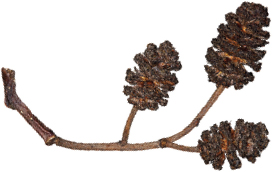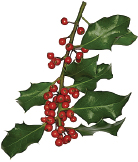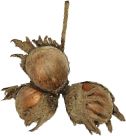
Fruits develop following fertilisation of female flowers and are the structures in which a tree or shrub produces its seeds. The appearance of these fruits is as varied as are the trees themselves and a number of ornate, and sometimes colourful, structures are easily recognised. In almost all tree and shrub species, dispersal of the seeds away from the parent plant is essential because it reduces competition for nutrients and available light. The means by which any given species achieves dispersal is often a major influence on the appearance of its fruit, and sometimes of the seeds themselves. Some use wind power and have winged seeds to carry them away, while others surround their fruits by luscious flesh to attract birds or mammals, which eat the fruits without digesting the seeds; these are then spread in their droppings. The seeds of a few species are carried and dispersed by water.
The names by which fruits are known are varied and most people will be familiar with terms such as berry and nut. In botanical parlance, however, there are a number of other ways in which fruits are described. Confusingly, there are many instances where structures that people refer to as nuts or berries, for example, may have an altogether different classification in the strict botanical sense.
On these pages I have tried to illustrate as wide a selection of fruit structure as space permits, but have chosen to keep the nomenclature simple. However, the following definitions of fruit types may help the reader cross-refer to other, more detailed, tree books:
Achene – a dry, indehiscent, one-seeded fruit with a papery case.
Berry – a succulent fruit containing several seeds that lack a hard case.
Capsule – a dry, many-seeded, dehiscent fruit.
Cone – a compact, usually woody structure comprising a central axis bearing radiating, seed-bearing tiers.
Drupe – a succulent or spongy fruit, usually one-seeded, the seed with a hard case.
Nut – a dry, indehiscent, one-seeded fruit with a hard, woody case.

Japanese Larch cones, seeds borne between the scales.


Monterey Pine cone and winged seed.

Monterey Cypress cone, seeds borne between the scales.

Giant Redwood cone, seeds borne between the scales.


Norway Spruce cone and winged seed.

Eucalyptus fruits (woody capsules, not cones).


Alder cones and seeds, which float on water.


Ash; a cluster of winged seeds and an individual seed (technically, an achene).

Silver Birch seed (technically, a nut).

Sycamore, paired and winged seeds.

Field Maple, paired and winged seeds.

Alder Buckthorn berry.

Whitebeam berries.

Hawthorn berries.

Wild Service-tree berries.

Guelder-rose fruits (technically, drupes).

Holly fruits (technically, drupes).


Sweet Chestnut fruit and individual nut.

Beech fruit, in which nuts are contained.


Hazel nut cluster and individual nut.

Sessile Oak acorn (nut).

Pedunculate Oak acorns (nuts).

Walnut ‘nut’ (technically, a drupe, the spongy outer layer having been removed here).

Almond ‘nut’ (technically, a drupe, the spongy outer layer having been removed here).

Wild Crab.

London Plane fruits (technically, a cluster of achenes).

Cultivated Apple, showing cross section and pips.